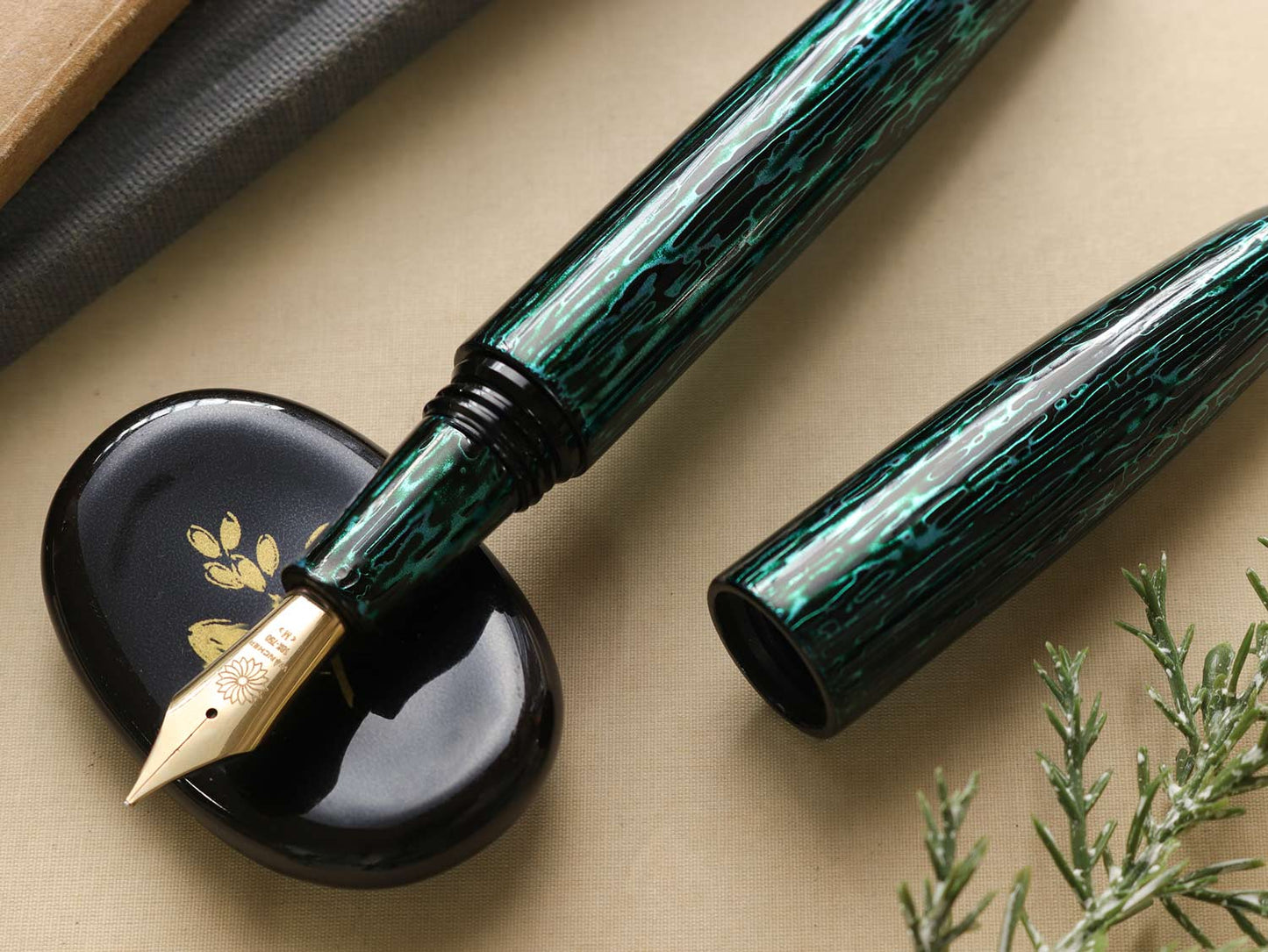Yakumo-nuri Shibo Urushi - Sazanami
Yakumo-nuri Shibo Urushi - Sazanami
Couldn't load pickup availability
Description
Description
Notice: Each Urushi fountain pen is handcrafted with no two pieces exactly alike, which is a valuable characteristic of hand-crafted art. Therefore, the pen that you received might be slightly different from the prototype pictures, yet, at the same time, it will be a unique artwork of your own.
The Origin of Yakumo-nuri
Yakumo-nuri is a legendary Urushi (Japanese lacquer) technique that originated in Matsue City of Shimane Prefecture. Despite its reputation for beauty, it is a relatively young art style, having been invented by Matsue lacquer artist Heiichi Sakata in the early Meiji period. The name ‘Yakumo’ was invented by Heiichi Sakata, who was reportedly inspired by the oldest Japanese poem - Yakumo Tatsu.
Izumo is a land protected by clouds aplenty
And like this land of Izumo
I shall build a fence to protect the palace
Where my wife will live
Like the clouds in this land of Izumo
This poem was supposedly spoken by the Japanese deity, Susa-no-O, after his valiant defeat of the eight-headed serpent of Japanese folklore, Yamata-no-Orochi. As one of the three most important deities of Japan, Susa-no-O (also known as Susanoo-no-Mikoto) is the younger brother of the Sun Goddess Amaterasu and the Moon God Tsukuyomi. Unlike his divine siblings, Susa-no-O was portrayed as a volatile yet heroic deity who was more relatable to his human subjects. His volatility is on full display in the story of how, during one of Susanō’s fits of rage, Amaterasu took shelter in a cave, which doomed the entire world to darkness.
However, Susanō is also portrayed for his heroic tendencies, such as when he happened upon a tearful goodbye between Kushinada-hime and her parents. Flummoxed by their sorrow, Susanō asked them the reason for their tears, they explained that the fearsome Yamata-no-Orochi had devoured their eight daughters, and their last daughter - Kushinada-hime - would be the next sacrifice. Susanō felt moved by this display of emotion, and offered to vanquish Yamata-no-Orochi in exchange for Kushinada-hime’s hand in marriage. Susanō ingeniously tricked Yamata-no-Orochi into drinking vats of sake (Japanese rice wine) until it had fallen drunk. As it slumbered, Susanō cut the serpent into pieces and discovered the sword known as Kusanagi-no-Tsurugu, which would later become one of the three Imperial Treasures of Japan.
Historians have long dissected this legend for metaphors, references to historically significant events, and cultural traditions, and while their theories will never be confirmed, many of the locations of this particular legend can still be seen and enjoyed today in Shimane Prefecture.
The Design
Shibo Urushi (Patterned Urushi)
The metallic shine unique to metal powder gives a somewhat futuristic impression. The pattern is drawn onto the pen with metal powder, then Urushi is applied on the surface before the artisan polishes it, allowing the metal to shine through.
Shibo Urushi is laudable for its masterful combination of different features to create one fully realized work of art. The artisan begins by drawing patterns upon a base layer of Urushi, refined gold or metallic powder multiple times. Once the thickness of the layer is achieved, the surface is scraped to reveal the pattern and then polished to shine.
The most unique aspect of Yakumo-nuri is its ability to transform. This means that with time and usage, this final layer will be brighter, allowing you to enjoy the changes. This aspect allows the distinct patterns underneath all of the layers of Urushi to become more prominent with continued use, almost as if the pen is evolving right alongside you.
Sazanami: The color of this pen is inspired by the gentle, yet powerful ripples that can be found when droplets of rain make contact with the deep blue waves of the sea.
The Artisan: Nagaya Momoko
Born in Matsue City, Shimane Prefecture, Nagaya Momoko graduated from the illustrious Kanagawa College of Art before opening her own studio in the city of Izumo.
With the aim of preserving and developing the local traditional craft of Yakumo-nuri, she works on creating artworks that masterfully meld modern innovations with traditional Yakumo-nuri.
When we learned of Nagaya Momoko’s personal philosophy, it was clear that it aligned with our own commitment to preserving traditional arts, which is why we hope our collaboration will be the beginning of more artworks that can raise awareness of these underrated techniques.
Specifications
Base material: Ebonite
Art: Yakumo-nuri, Shibo Urushi
Filling mechanism: Converter or Cartridge (European International Standard)
Nib: #6 Jowo stainless steel, Wancher 18K gold, Keiryu/Kodachi
Feed: Plastic, ebonite black, ebonite red
Compact air-tight cap: Preven dried-out ink problem

Packaging
Traditional Japanese Wooden Box + Pen Kimono + Instructional Materials + Converter + Cartridge
Duties & Taxes
Duties & Taxes
For international orders, customers are responsible for any sales tax, duties, brokerage fees, and / or other taxes imposed by the government of the destination country, in addition to the quoted or invoiced price.
Learn about Wancher's terms of service for our premium fountain pens and writing instruments. Find important information on purchases, warranties, and customer rights. Essential reading for all Wancher pen enthusiasts and collectors.Share










